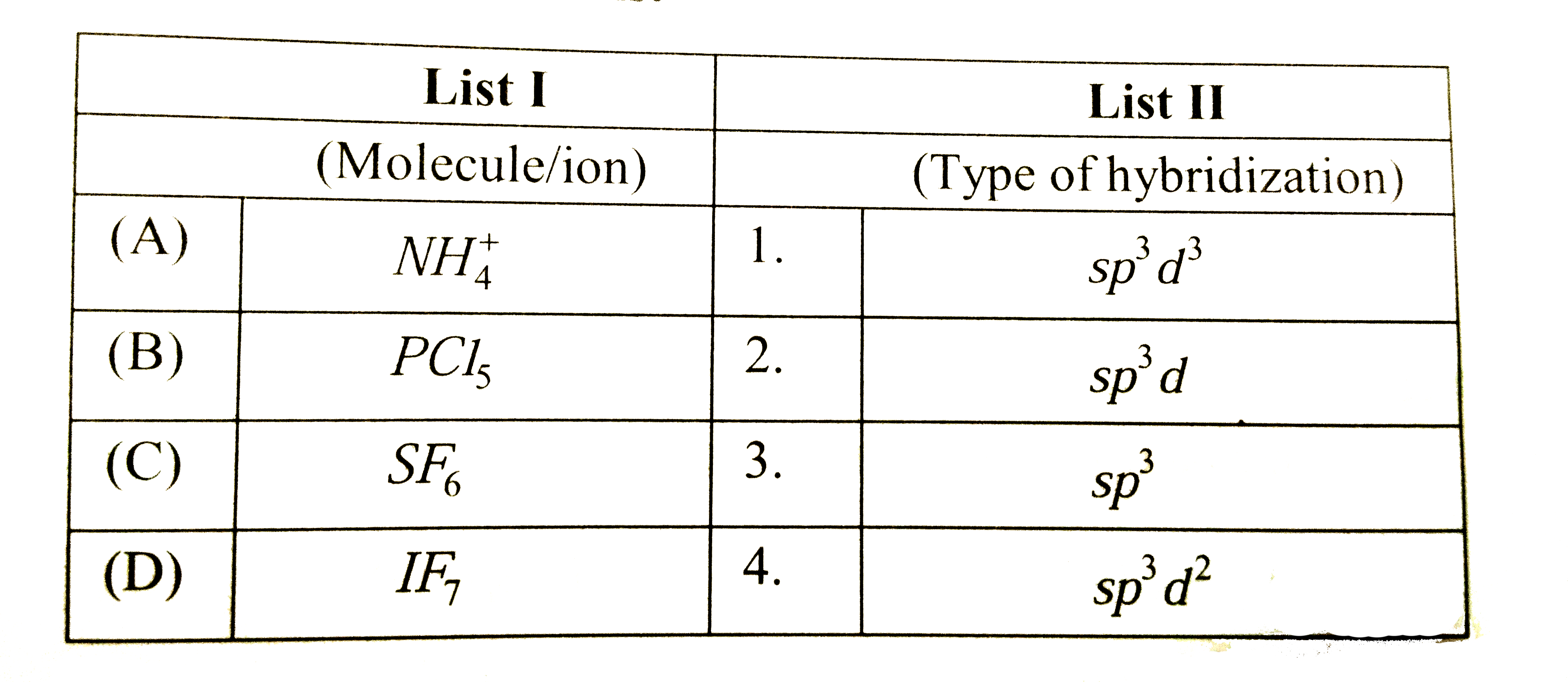Match List-I (Complexes) with List-II (Hybridization) of central atom and select the correct answer using the codes given below the lists:
(i) and (ii)
(i) and (iii)
(ii) and (iv)
(i), (ii) and (iv)
The correct Answer is:C
= =
= = d^(2)sp^(2)F^(-) is a weak ligand and can not force. Force d-electrons to pair up forming outer orbital complex.
Topper's Solved these Questions
- CO-ORDINATION COMPOUNDS BOOK - DINESH PUBLICATIONCHAPTER - CO-ORDINATION COMPOUNDS EXERCISE - SELECTED STRAIGHT OBJECTIVE TYPE MCQS
84 Videos
- CO-ORDINATION COMPOUNDS BOOK - DINESH PUBLICATIONCHAPTER - CO-ORDINATION COMPOUNDS EXERCISE - COMPREHENNSION TYPE MCQS
5 Videos
- CO-ORDINATION COMPOUNDS BOOK - DINESH PUBLICATIONCHAPTER - CO-ORDINATION COMPOUNDS EXERCISE - Brain storming multiple choice question
12 Videos
- CHEMISTRY IN EVERY DAY LIFEBOOK - DINESH PUBLICATIONCHAPTER - CHEMISTRY IN EVERY DAY LIFEEXERCISE - Unit test-9
50 Videos
- CYANIDES, ISOCYANIDES, NITROCOMPOUNDS AND AMINESBOOK - DINESH PUBLICATIONCHAPTER - CYANIDES, ISOCYANIDES, NITROCOMPOUNDS AND AMINESEXERCISE - Unit test - 8
20 Videos
Similar Questions
Match List I with List II. Select the correct answer using the codes given below the list

Answer the code
View SolutionMatch List-I (Minerals) with List-II (Major Areas in U.S.A.) and select the correct answer using the codes given below the lists:

(a) ABCD2431 (b) ABCD1352
(c) ABCD1432 (d) ABCD2351
View Solution
Knowledge Check
Match List-I (Complexes)with List-II (Hybridization ) of central atom ans select the correct answer using the codes given below the lists :
 AABCD1324BABCD5243CABCD5324DABCD1243
AABCD1324BABCD5243CABCD5324DABCD1243Match List-I (complex ions) with List-II (number of unpaired electrons) and select the correct answers using the codes given below lists:
List−IList−II(Complexion)(NumberofUnpairedElectrons)A.[CrF6]4−1.OneB.[MnF6]4−2.TwoC.[Cr(CN)6]4−3.ThreeD.[Mn(CN)6]4−4.Four5.FiveA(a) ABCD4125B(b) ABCD2531C(c) ABCD4521D(d) ABCD2135Match List-I (Minerals) with List-II (Places) and select the correct answer using the codes given below the lists:

(a) ABCD1342 (b) ABCD4312
(c) ABCD1243 (d) ABCD4213AABCD1342BABCD4312CABCD1243DABCD4213
Match the complexed listed column −I with type of hybridisation listed in column −II and select the correct answer using the code given below the lists :
Column−IColumn−II(a)[AuF4]−(p) dsp2hybridisation(b)[Cu(CN)4]3−(q) sp3hybridisation(c)[Co(NH3)6]3+(r) sp3d2hybridisation(d)[Fe(H2O)5NO]2+(s) d2sp3hybridisation
View SolutionMatch List-I (Country) with List-II (Name of Parliament) and select the correct answer using the codes given below the lists
List-IList-IIA.Netherlands1.DietB.Ukraine2.States GeneralC.Poland3.Supreme CouncilD.Japan4.Sejm
View SolutionMatch List-I (Humidity Provinces) with List-II (Characteristic Natural Vegetation) and select correct answer by using the codes given below the lists
List-I List-IIA. Wet1. ForestB. Humid2. RainforestC. Semi-arid3. ScrubD. Arid4. Steppe
View SolutionMatch List- I (particle) with List - II (approximate rast energy in Me V) and select the correct answer using the codes gives below the lists -
List- I List-IIA. Electron 1. 940B. Neutrino 2. 140 C. Neutron 3. 0.5 D. Pi- Meson 4. 0
View SolutionMatch list I with list II and select the correct answer using the codes given below the lists
List IList IIMetal IonsMagnetic moment (B,M)A.Cr3+1.√35B.Fe2+2.√30C.Ni2+3.√24D.Mn2+4.√155.√8
View Solution
